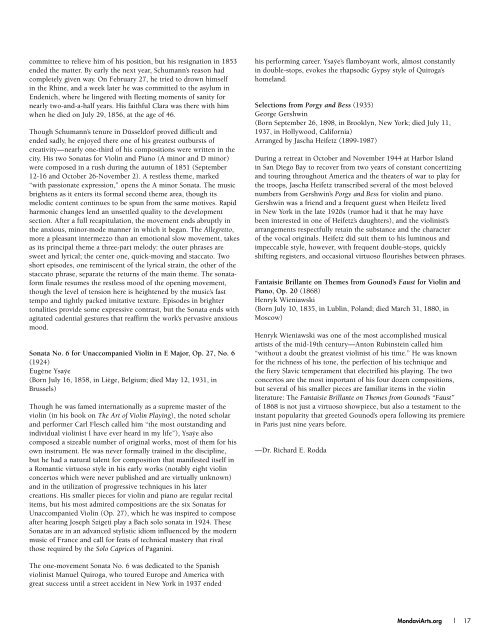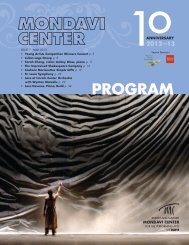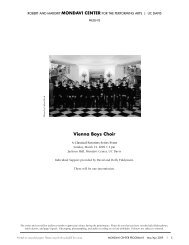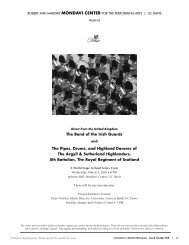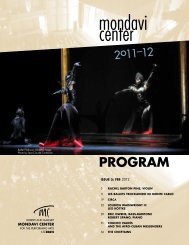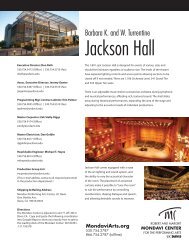Create successful ePaper yourself
Turn your PDF publications into a flip-book with our unique Google optimized e-Paper software.
committee to relieve him of his position, but his resignation in 1853<br />
ended the matter. By early the next year, Schumann’s reason had<br />
completely given way. On February 27, he tried to drown himself<br />
in the Rhine, and a week later he was committed to the asylum in<br />
Endenich, where he lingered with fleeting moments of sanity for<br />
nearly two-and-a-half years. His faithful Clara was there with him<br />
when he died on July 29, 1856, at the age of 46.<br />
Though Schumann’s tenure in Düsseldorf proved difficult and<br />
ended sadly, he enjoyed there one of his greatest outbursts of<br />
creativity—nearly one-third of his compositions were written in the<br />
city. His two Sonatas for Violin and Piano (A minor and D minor)<br />
were composed in a rush during the autumn of 1851 (September<br />
12-16 and October 26-November 2). A restless theme, marked<br />
“with passionate expression,” opens the A minor Sonata. The music<br />
brightens as it enters its formal second theme area, though its<br />
melodic content continues to be spun from the same motives. Rapid<br />
harmonic changes lend an unsettled quality to the development<br />
section. After a full recapitulation, the movement ends abruptly in<br />
the anxious, minor-mode manner in which it began. The Allegretto,<br />
more a pleasant intermezzo than an emotional slow movement, takes<br />
as its principal theme a three-part melody: the outer phrases are<br />
sweet and lyrical; the center one, quick-moving and staccato. Two<br />
short episodes, one reminiscent of the lyrical strain, the other of the<br />
staccato phrase, separate the returns of the main theme. The sonataform<br />
finale resumes the restless mood of the opening movement,<br />
though the level of tension here is heightened by the music’s fast<br />
tempo and tightly packed imitative texture. Episodes in brighter<br />
tonalities provide some expressive contrast, but the Sonata ends with<br />
agitated cadential gestures that reaffirm the work’s pervasive anxious<br />
mood.<br />
Sonata No. 6 for Unaccompanied Violin in E Major, Op. 27, No. 6<br />
(1924)<br />
Eugène Ysaÿe<br />
(Born July 16, 1858, in Liège, Belgium; died May 12, 1931, in<br />
Brussels)<br />
Though he was famed internationally as a supreme master of the<br />
violin (in his book on The Art of Violin Playing), the noted scholar<br />
and performer Carl Flesch called him “the most outstanding and<br />
individual violinist I have ever heard in my life”), Ysaÿe also<br />
composed a sizeable number of original works, most of them for his<br />
own instrument. He was never formally trained in the discipline,<br />
but he had a natural talent for composition that manifested itself in<br />
a Romantic virtuoso style in his early works (notably eight violin<br />
concertos which were never published and are virtually unknown)<br />
and in the utilization of progressive techniques in his later<br />
creations. His smaller pieces for violin and piano are regular recital<br />
items, but his most admired compositions are the six Sonatas for<br />
Unaccompanied Violin (Op. 27), which he was inspired to compose<br />
after hearing Joseph Szigeti play a Bach solo sonata in 1924. These<br />
Sonatas are in an advanced stylistic idiom influenced by the modern<br />
music of France and call for feats of technical mastery that rival<br />
those required by the Solo Caprices of Paganini.<br />
The one-movement Sonata No. 6 was dedicated to the Spanish<br />
violinist Manuel Quiroga, who toured Europe and America with<br />
great success until a street accident in New York in 1937 ended<br />
his performing career. Ysaÿe’s flamboyant work, almost constantly<br />
in double-stops, evokes the rhapsodic Gypsy style of Quiroga’s<br />
homeland.<br />
Selections from Porgy and Bess (1935)<br />
George Gershwin<br />
(Born September 26, 1898, in Brooklyn, New York; died July 11,<br />
1937, in Hollywood, California)<br />
Arranged by Jascha Heifetz (1899-1987)<br />
During a retreat in October and November 1944 at Harbor Island<br />
in San Diego Bay to recover from two years of constant concertizing<br />
and touring throughout America and the theaters of war to play for<br />
the troops, Jascha Heifetz transcribed several of the most beloved<br />
numbers from Gershwin’s Porgy and Bess for violin and piano.<br />
Gershwin was a friend and a frequent guest when Heifetz lived<br />
in New York in the late 1920s (rumor had it that he may have<br />
been interested in one of Heifetz’s daughters), and the violinist’s<br />
arrangements respectfully retain the substance and the character<br />
of the vocal originals. Heifetz did suit them to his luminous and<br />
impeccable style, however, with frequent double-stops, quickly<br />
shifting registers, and occasional virtuoso flourishes between phrases.<br />
Fantaisie Brillante on Themes from Gounod’s Faust for Violin and<br />
Piano, Op. 20 (1868)<br />
Henryk Wieniawski<br />
(Born July 10, 1835, in Lublin, Poland; died March 31, 1880, in<br />
Moscow)<br />
Henryk Wieniawski was one of the most accomplished musical<br />
artists of the mid-19th century—Anton Rubinstein called him<br />
“without a doubt the greatest violinist of his time.” He was known<br />
for the richness of his tone, the perfection of his technique and<br />
the fiery Slavic temperament that electrified his playing. The two<br />
concertos are the most important of his four dozen compositions,<br />
but several of his smaller pieces are familiar items in the violin<br />
literature: The Fantaisie Brillante on Themes from Gounod’s “Faust”<br />
of 1868 is not just a virtuoso showpiece, but also a testament to the<br />
instant popularity that greeted Gounod’s opera following its premiere<br />
in Paris just nine years before.<br />
—Dr. Richard E. Rodda<br />
<strong>Mondavi</strong>Arts.org | 17


